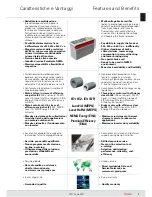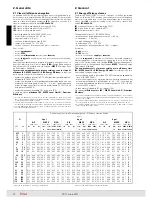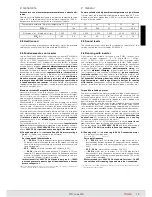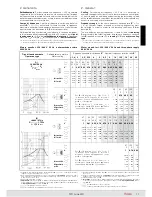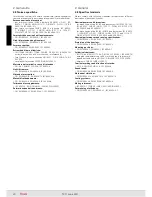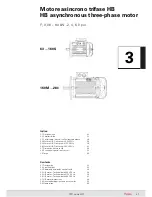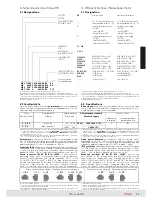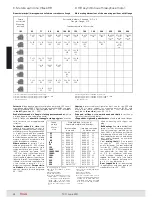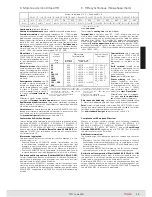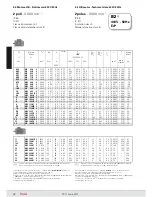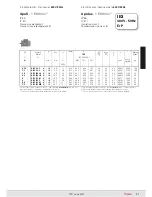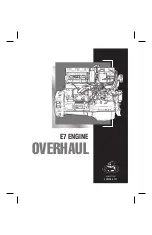
17
TX11 June 2011
Raffreddamento
. Per funzionamenti a frequenze
35,5 Hz valutare
l’opportunità (sotto l’aspetto sia termico sia economico) dell’impiego
del servoventilatore assiale (in funzione di entità e durata del carico e
della temperatura ambiente) per evitare di dover sovradimensionare
eccessivamente il motore-inverter.
Campo di frequenza
. A parità di rapporto di variazione della fre-
quenza
R
1)
=
f
max
/
f
min
a momento torcente costante, le frequenze
massima e minima di funzionamento devono essere scelte in modo
da ottimizzare il declassamento
C
(
C
massimo possibile).
Nella tabella di seguito riportata sono indicate, in funzione del rappor-
to di variazione della frequenza
R
richiesto a
M
costante, del
tipo di
funzionamento
(A, B) e del
raffreddamento motore
, le frequenze
massima
f
max
e minima
f
min
di funzionamento e il
declassamento C
.
Cooling
. For running at frequency
35,5 Hz it is necessary to
evaluate the opportunity (both from a thermal and economical point
of view) to apply an axial independent cooling fan (according to load
entity and duration and to ambient temperature) in order to avoid any
excessive oversizing of motor-inverter.
Frequency range
. At the same frequency variation ratio
R
1)
=
f
max
/
f
min
at constant torque, max and min running frequencies must
be selected in order to minimize the derating coefficient
C
(max
possible
C
).
The min and max running frequencies
f
min
and
f
max
and the
derating
C
are stated in the following table, according to frequency variation
ratio
R
required at constant
M
, to
running
(A, B) and
motor cooling
type
.
1) Il rapporto nominale di variazione della frequenza
R
=
f
max
/
f
min
è sempre minore del
rapporto effettivo di variazione (
n
max
/
n
min
).
2) Velocità reale approssimativa che tiene conto sia dello
scorrimento
a momento nomi-
nale, sia del boost di tensione alle basse frequenze (2 = motore a 2 poli; 4 = motore a
4 poli; 6 = motore a 6 poli).
3) Valori validi per grand.
160S.
4)
Importante
: per i motori grand.
160M o contrassegnati nel programma di fabbricazio-
ne dal simbolo
o nel caso di inverter con forma d’onda «scadente» considerare valori
di
C più prudenziali
, per esempio
0,9 · C
.
Sconsigliato per motivi economici.
Normalmente sconsigliato per motivi tecnici ed economici.
1) Nominal frequency variation ratio
R
=
f
max
/
f
min
is always lower than real variation ratio
(
n
max
/
n
min
).
2) Approx. real speed refers both to
slipping
at nominal torque and to voltage boost at low
frequency (2 = 2 poles motor; 4 = 4 poles motor; 6 = 6 poles motor).
3) Values valid for sizes
160S.
4)
Important
: for motor sizes
160M or signed in the manufacturing programme by symbol
or in case of inverter with low quality wave shape, consider
more prudential C
values,
e.g.
0,9 · C
.
Not advisable for economic reasons.
Usually not advisable both for technical and economic reasons.
2. Generalità
2. General
1) Si devono considerare solo i valori di frequenza (e quindi velocità) legati all’applicazione
e non quelli (solitamente bassi) caratteristici delle fasi di transitorio.
1) It is necessary to consider only the frequency (i.e. speed) values relevant to the applica-
tion and not the (usually low) ones characteristic of transients.
Motore avvolto
230
Y
400 V 50 Hz e alimentazione trifase
400 V 50 Hz.
Motor wound for
230
Y
400 V 50 Hz and three-phase supply
400 V 50 Hz.
1
1
2
2
Tipo di funzionamento
Raffreddamento motore
Operation type
Motor cooling
Rapporto nominale di variazione
R
1)
- Nominal frequency variation ratio
R
1)
1,4 2
2,5 3,15
4
5
6,3
8
10 12,5 16
20
25
A)
Y400 V/50 Hz
P
a/at n max
=
P
N
I
=
I
N 400 V
B)
400 V/87 Hz
P
a/at n max
=
1,73
P
N
I
=
1,73
I
N 400 V
Autoventilato
Self-cooled
Servoventilato
Independently
cooled
Autoventilato
Self-cooled
Servoventilato
Independently
cooled
f
max
50
54,5 60
63
67
71
75
80
85
90
–
–
–
f
min
35,5 28
23,6 20
17
14
11,8 10
8,5
7,1 –
–
–
C
4)
1
0,91 0,85 0,79 0,74 0,7 0,66 0,62 0,59 0,56 –
–
–
n
max 2
2) 3)
2 820 3 105 3 440 3 630 3 880 4 125 4 370 4 675 4 980 5 285
–
–
–
n
min 2
2) 3)
1 960 1 535 1 285 1 080
915
745
620
520
435
360
–
–
–
n
max 4
2)
1 410 1 550 1 720 1 815 1 940 2 060 2 185 2 340 2 490 2 645
–
–
–
n
min 4
2)
980
770
645
540
460
370
310
260
220
180
–
–
–
n
max 6
2)
930 1 025 1 140 1 200 1 285 1 365 1 450 1 550 1 655 1 755
–
–
–
n
min 6
2)
645
505
420
355
300
240
200
170
140
115
–
–
–
f
max
50 63
80 100
–
f
min
5 5
5 5
–
C
4)
1
0,79 0,62 0,5
–
n
max 2
2) 3)
2 820 3 630 4 675 5 895
–
n
min 2
2) 3)
190
210
230
245
–
n
max 4
2)
1 410 1 815 2 340 2 950
–
n
min 4
2)
95
105
115
120
–
n
max 6
2)
930 1 200 1 550 1 960
–
n
min 6
2)
55
65
75
80
–
f
max
87
90 95
100 106 112 118
125 140 150
–
f
min
35,5 28 23,6
20
17
14 11,8 10
8,5
7,1 –
C
4)
1
0,91 0,85 0,79 0,74 0,7 0,66 0,62 0,59 0,56 –
n
max 2
2) 3)
5 020 5 215 5 525 5 835
–
–
–
–
–
–
–
n
min 2
2) 3)
1 960 1 535 1 285 1 080
–
–
–
–
–
–
–
n
max 4
2)
2 510 2 610 2 765 2 920 3 105 3 285 3 470 3 685 4 135 4 435
–
n
min 4
2)
980
770
645
540
460
370
310
260
220
180
–
n
max 6
2)
1 660 1 730 1 835 1 935 2 060 2 180 2 305 2 450 2 750 2 950
–
n
min 6
2)
645
505
420
355
300
240
200
170
140
115
–
Per
R
10 scegliere
f
max
50 e
f
min
5
in funzione delle esigenze di velocità e
mo mento richiesti dall’applicazione (sem-
pre
C
= 1); interpellarci.
For
R
10 choose
f
max
50 and
f
min
5
ac cording to speed and torque application
re quirements (always
C
= 1); consult us.
f
max
87 100 125
f
min
5 5 5
C
4)
1
0,79 0,62
n
max 2
2) 3)
5 020 5 835
–
n
min 2
2) 3)
190
210
–
n
max 4
2)
2 510 2 920 3 685
n
min 4
2)
95
105
115
n
max 6
2)
1 660 1 935 2 450
n
min 6
2)
55
65
75
Per
R
16 scegliere
f
max
87 e
f
min
5
in funzione delle esigenze di velocità e
mo mento richiesti dall’applicazione (sem-
pre
C
= 1); interpellarci.
For
R
16 choose
f
max
87 and
f
min
5
ac cording to speed and torque application
re quirements (always
C
= 1); consult us.
Summary of Contents for TX11 Series
Page 2: ......
Page 203: ...203 TX11 June 2011...



